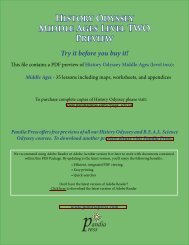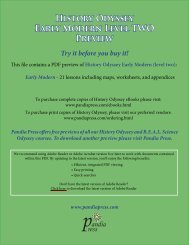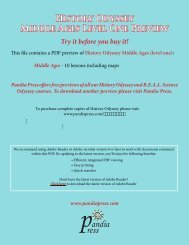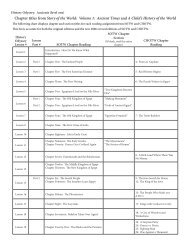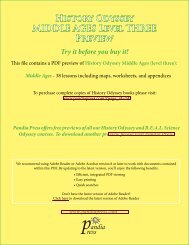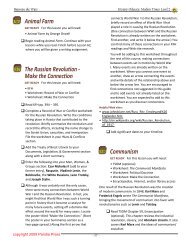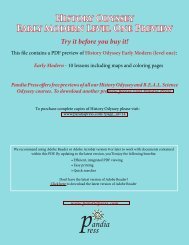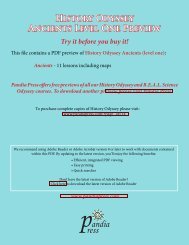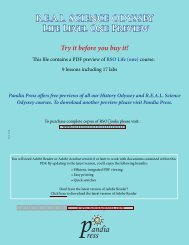Amos Fortune: Free Man India East India Trading ... - Pandia Press
Amos Fortune: Free Man India East India Trading ... - Pandia Press
Amos Fortune: Free Man India East India Trading ... - Pandia Press
You also want an ePaper? Increase the reach of your titles
YUMPU automatically turns print PDFs into web optimized ePapers that Google loves.
20<br />
21<br />
Lesson<br />
<strong>Pandia</strong> <strong>Press</strong><br />
<strong>India</strong><br />
GET READY For this lesson you will need:<br />
•y KFH<br />
•y Map 6, <strong>India</strong><br />
•y Fine-point black pen or pencil<br />
•y Atlas<br />
Read KFH p. 265 and pp. 298 - 299.<br />
Create a three-level outline on <strong>India</strong>’s history<br />
from 1600-1850 from your readings in KFH.<br />
Include information about the rise and fall of<br />
the Mogul Empire, the British in <strong>India</strong>, and the<br />
<strong>East</strong> <strong>India</strong> <strong>Trading</strong> Companies.<br />
<br />
On Map 6, use your atlas and the map on<br />
KFH p. 298 to label:<br />
<strong>India</strong> Pakistan (modern-day)<br />
Delhi Ceylon (Sri Lanka)<br />
Madras Arabian Sea<br />
Bay of Bengal<br />
Add the Taj Mahal to the Art, Inventions, &<br />
Architecture section of your binder along with a<br />
short summary and sketch.<br />
Add Akbar and Aurangzeb to your Men &<br />
Women section along with short summaries.<br />
Add significant dates to your timeline.<br />
<strong>East</strong> <strong>India</strong> <strong>Trading</strong> Companies<br />
GET READY For this lesson you will need:<br />
•y KFH<br />
•y Map 7, <strong>East</strong> <strong>India</strong> <strong>Trading</strong> Companies<br />
•y Fine-point black pen or pencil<br />
•y Atlas<br />
In the 17 th century the Dutch (from the Netherlands),<br />
the English, and the French competed with each other<br />
for the trade (mostly spices) in Indonesia and <strong>India</strong>. They<br />
formed powerful organizations called the <strong>East</strong> <strong>India</strong><br />
Companies.<br />
Read KFH p. 258 and p. 259.<br />
Record a few dates on your timeline.<br />
<br />
Choose one of the following assignments:<br />
Part I<br />
1. Summarize the <strong>East</strong> <strong>India</strong> Companies in your<br />
Summaries section. Write a general summary<br />
describing the purpose of the <strong>East</strong> <strong>India</strong><br />
Companies. Summarize the Dutch, English,<br />
and French <strong>East</strong> <strong>India</strong> Companies. Record the<br />
locations where they controlled trade, what they<br />
traded, and dates.<br />
2. Create a presentation on the history of the <strong>East</strong><br />
<strong>India</strong> <strong>Trading</strong> Companies using presentation<br />
software such as PowerPoint, Keynote, or Corel<br />
Presentations. Use charts, maps, pictures, and<br />
other effects in your presentation.<br />
Two Web sites that do a wonderful job of presenting the<br />
story of the <strong>East</strong> <strong>India</strong> <strong>Trading</strong> Companies and provide many<br />
images for your presentation:<br />
•x www.footmarkmedia.co.uk/bltp/main.htm<br />
•x www.bl.uk/learning/histcitizen/trading/tradingplaces.<br />
html<br />
Lesson<br />
<br />
On Map 7, use your atlas to label the<br />
following:<br />
<strong>India</strong> London<br />
Portugal The Netherlands (Holland)<br />
Japan Africa<br />
France Atlantic Ocean<br />
England Spice Islands (Indonesia)<br />
Bombay Philippines<br />
<strong>India</strong>n Ocean<br />
Draw at least three trade routes on your<br />
map as described in KFH. For example,<br />
draw the trade route taken by the Dutch<br />
from Holland to the Cape of Good Hope to<br />
the <strong>East</strong> Indies and back again.<br />
<strong>Amos</strong> <strong>Fortune</strong>: <strong>Free</strong> <strong>Man</strong><br />
GET READY For this lesson you will need:<br />
• y <strong>Amos</strong> <strong>Fortune</strong>: <strong>Free</strong> <strong>Man</strong> by Elizabeth Yates<br />
Begin reading <strong>Amos</strong> <strong>Fortune</strong>: <strong>Free</strong> <strong>Man</strong> by<br />
Elizabeth Yates. This biography is based on<br />
primary source documents written by <strong>Amos</strong><br />
<strong>Fortune</strong> himself. Continue with your lessons<br />
Lesson<br />
22<br />
- 18 -
Trade and Rebellion History Odyssey: Early Modern Level 2<br />
while reading this book. Complete your reading<br />
before Lesson 27.<br />
25<br />
23<br />
Lesson African States<br />
GET READY For this lesson you will need:<br />
•y KFH<br />
th<br />
• y Map 8, Africa and the Slave Trade, 16 to 19 th<br />
Centuries<br />
•y Fine-point black pen or pencil<br />
•y Colored pencils<br />
•y Atlas<br />
Read KFH pp. 272 - 273.<br />
Create a three-level outline of this reading.<br />
<br />
On Map 8, look in your atlas and on p.<br />
272 of KFH to label Africa and the African<br />
states of Oyo, Benin, Ethiopia, and Ashanti.<br />
Are these the modern-day names of these<br />
historic African states<br />
Also label the Atlantic Ocean, North<br />
America, and Portugal.<br />
Draw a route from Africa to the Americas<br />
and label it “The Middle Passage.”<br />
Complete the map key identifying the<br />
Middle Passage. Shade Africa your second<br />
favorite color.<br />
Add significant dates to your timeline.<br />
24<br />
Lesson African States (cont.)<br />
GET READY For this lesson you will need:<br />
•y Appendix F: Firsthand Account of the Slave<br />
Trade<br />
•y Worksheet: Evaluating Sources<br />
q Read “Firsthand Account of the Slave Trade”<br />
found in Appendix F.<br />
Complete a copy of the “Evaluating Sources”<br />
worksheet. Place the completed worksheet in<br />
the Summaries section of your binder.<br />
- 19 -<br />
Lesson<br />
26<br />
Lesson<br />
Trade and Pirates<br />
GET READY For this lesson you will need:<br />
•y KFH<br />
th<br />
• y Map 8, Africa and the Slave Trade, 16 to 19 th<br />
Centuries<br />
•y Fine-point black pen or pencil<br />
•y Colored pencils<br />
•y Atlas<br />
Read KFH pp. 270 - 271.<br />
<br />
On Map 8, label South America, the<br />
West Indies, the Caribbean Sea, Jamaica,<br />
and Europe. Draw the slave triangle as<br />
represented in KFH on p. 270. Complete<br />
the map key.<br />
Add the following to your Men & Women<br />
section along with short summaries:<br />
Francis Drake<br />
Captain Kidd<br />
Edward Teach (Blackbeard)<br />
Captain Henry Morgan<br />
Add significant dates to your timeline.<br />
Mercantilism and Trade<br />
GET READY For this lesson you will need:<br />
•y TSOM<br />
•y Internet access<br />
•y <strong>Amos</strong> <strong>Fortune</strong>: <strong>Free</strong> <strong>Man</strong><br />
During the 17 th and 18 th centuries, England<br />
was engaged in a type of economic policy called<br />
mercantilism—the idea that a country’s power<br />
depended on its wealth, and a country’s wealth<br />
depended upon a favorable balance of trade—selling<br />
more goods to other countries than it bought (i.e.<br />
more exports than imports). If England earned more<br />
than it spent, then that equaled profits. England<br />
imposed Navigation Acts upon the colonists to<br />
control trade. Basically the colonies would supply<br />
England, and only England, raw products such as
<strong>Pandia</strong> <strong>Press</strong><br />
Part I<br />
tobacco, sugar, and indigo. Triangle trade routes<br />
were set up to support mercantilism including the<br />
triangle for the trading of slaves that you read about<br />
in the last lesson.<br />
Read TSOM chapter 50.<br />
If you have access to the Internet, read more about<br />
Mercantilism at these sites:<br />
•x score.rims.k12.ca.us/score_lessons/market_to_<br />
market/pages/mercantilism_imports_and_e.htm<br />
•x www.sparknotes.com/testprep/books/sat2/history/<br />
chapter5section4.rhtml<br />
Choose between these two assignments:<br />
1. Write a one- to two-page summary on<br />
mercantilism in the summary section of your<br />
binder. Define mercantilism and include<br />
information on how England used the raw<br />
materials provided by the American colonies<br />
to increase their wealth. Explain how England’s<br />
use of laws and tariffs controlled trade with the<br />
colonists. How do you think mercantilism both<br />
helped and hindered America<br />
2. Give a presentation on the effects of<br />
mercantilism and trade. Explain verbally and<br />
visually how mercantilism worked. Recruit<br />
volunteers to play the parts of the colonists,<br />
the English, the Africans, and others. Show the<br />
English imposing Navigation Acts and tariffs<br />
upon the colonists and demonstrate how the<br />
English made a profit. As part of your oral report,<br />
act out a trade triangle. Use props with your<br />
presentation and gather an audience. You might<br />
want to take pictures of your play presentation<br />
to put in the Summaries section of your binder.<br />
A few common trade triangles in the 17 th and 18 th centuries:<br />
27<br />
Lesson<br />
Challenge: Research and write a summary<br />
about free trade (a philosophy of trade<br />
practiced today) and describe how it differs<br />
from mercantilism.<br />
<br />
<br />
Finish reading <strong>Amos</strong> <strong>Fortune</strong>: <strong>Free</strong> <strong>Man</strong> before<br />
the next lesson.<br />
Merchantilism and Trade<br />
(cont.)<br />
GET READY For this lesson you will need:<br />
•y <strong>Amos</strong> <strong>Fortune</strong>: <strong>Free</strong> <strong>Man</strong><br />
Use the information you learned from <strong>Amos</strong><br />
<strong>Fortune</strong>: <strong>Free</strong> <strong>Man</strong> and from the last few<br />
lessons to write a fictitious letter to a friend<br />
about the slave trade. Pretend you are either a<br />
European ship owner who has just purchased<br />
slaves for transport to the West Indies or<br />
an American plantation owner who has just<br />
purchased slaves at a slave market. In the letter<br />
justify your decision to partake in the slave<br />
trade. How will you profit Where will the<br />
slaves go and for what will they be used Was<br />
it an easy decision Do you care for the wellbeing<br />
of the slaves What events are happening<br />
that contributed to your decision to sell or buy<br />
slaves<br />
Write a response back as the friend to the<br />
European ship owner or plantation owner<br />
criticizing the decision to participate in the slave<br />
trade. What could he have done differently<br />
Why was purchasing or buying slaves a wrong<br />
decision What are some alternatives to work<br />
and profits gained through slavery Why are<br />
the rights of individuals more important than<br />
the potential profits of slavery<br />
<br />
<strong>Man</strong>ufactured goods in England<br />
Tobacco in the colonies<br />
<br />
Fruits & nuts in the West Indies<br />
<br />
Molasses in the West Indies<br />
Lumber in the colonies<br />
<br />
<strong>Man</strong>ufactured goods in England<br />
<br />
Molasses in the West Indies<br />
Slaves in Africa<br />
Rum in the colonies<br />
<br />
- 20 -



